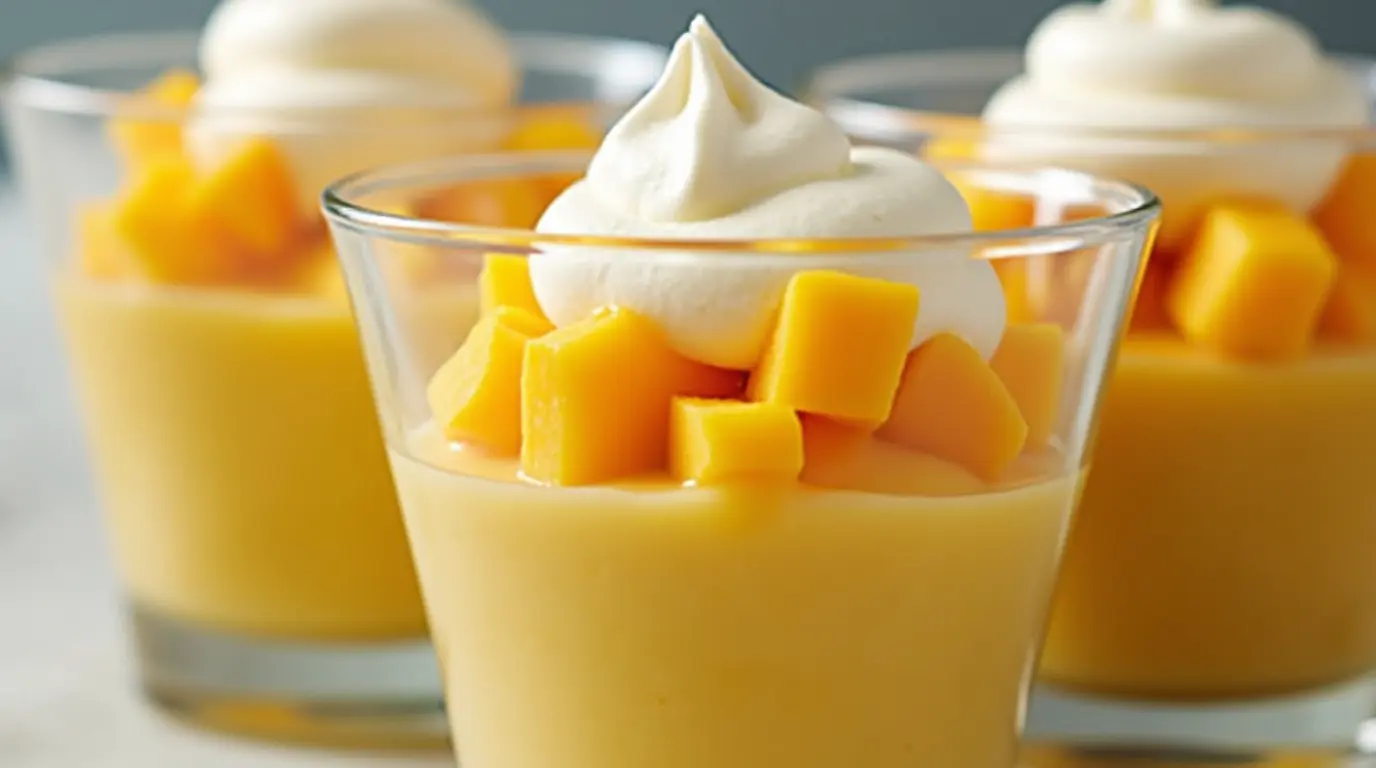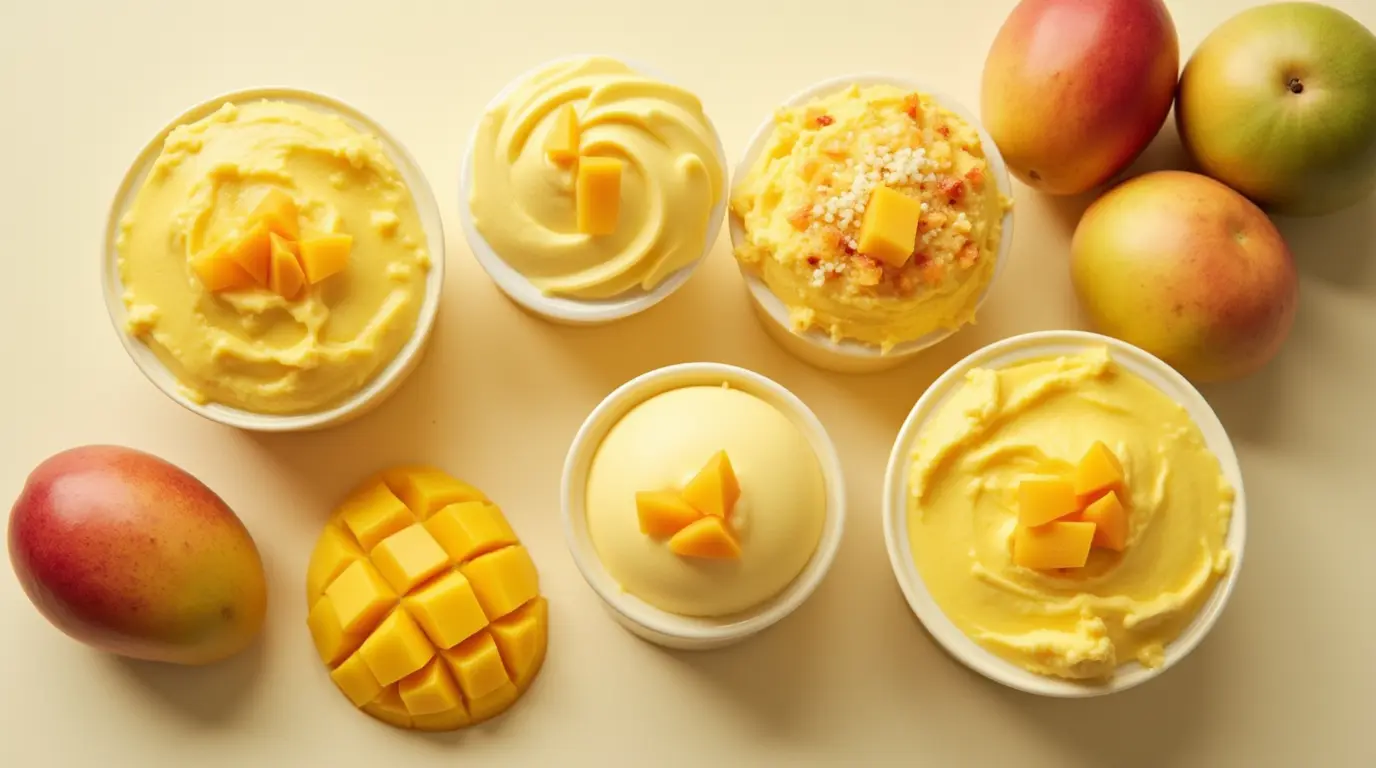There’s something magical about mango in a dessert, smooth, sweet, and sun-kissed.
Whether it’s swirled into mousse, folded into cheesecake, or chilled in a tropical tart, these mango desserts are the kind that steal the show at any table. Ready to taste summer in every bite?
Table of contents
Why Choose Mango Desserts?
The Versatility of Mangoes in Desserts
Mangoes are among the most versatile fruits, making them an ideal ingredient for desserts. Their naturally sweet and tangy flavor pairs seamlessly with a variety of other ingredients, such as creamy dairy, rich coconut milk, or warm spices like cardamom and cinnamon. Whether used fresh, as a puree, or even dried, mangoes adapt beautifully to different recipes.
From no-bake desserts like mousse and cheesecakes to baked treats and chilled sorbets, mangoes can transform into a variety of culinary delights. They can also be a star ingredient in both traditional and modern recipes, showcasing their global appeal.
Health Benefits of Mango Desserts
Mango desserts not only please your taste buds but also offer numerous health benefits. Mangoes are rich in vitamins A and C, both of which are essential for healthy skin, immune support, and overall well-being. They also contain fiber, antioxidants, and other nutrients that can make dessert time a slightly healthier indulgence.
By incorporating mangoes into your desserts, you’re adding natural sweetness and reducing the need for excessive added sugars. This makes mango-based treats a wholesome alternative to conventional sweets while still satisfying your cravings.
Must-Try Mango Desserts
Mango Pudding

Why It’s a Must-Try:
Mango pudding is a classic dessert that combines the creamy texture of pudding with the sweet and tangy flavor of fresh mangoes. It’s simple to prepare, requires minimal ingredients, and is loved by people of all ages.
How to Make It:
- Blend ripe mangoes into a smooth puree.
- Mix the puree with condensed milk, evaporated milk, and gelatin.
- Allow the mixture to set in the fridge for a few hours until firm.
- Serve chilled and garnish with fresh mango chunks or a drizzle of coconut cream for an extra tropical touch.
Pro Tips:
- Use Alphonso or Ataulfo mangoes for the sweetest flavor.
- Adjust the sweetness according to the ripeness of the mangoes.
Mango Cheesecake
Why It’s a Must-Try:
This decadent dessert pairs the richness of cream cheese with the vibrant flavor of mangoes. You can choose between a no-bake or baked version, depending on your preference and available time.
How to Make It:
- For a no-bake cheesecake, prepare a biscuit base using crushed graham crackers and melted butter.
- Whip together cream cheese, mango puree, sugar, and whipped cream to create the filling.
- Pour the filling over the biscuit base and refrigerate until set.
- Garnish with mango slices or a mango glaze for a stunning presentation.
Pro Tips:
- Incorporate a hint of lime juice to balance the sweetness.
- Experiment with layering mango chunks within the cheesecake for added texture.
Mango Sorbet
Why It’s a Must-Try:
Mango sorbet is the ultimate refreshing dessert, especially during hot summer days. It’s dairy-free, making it a perfect option for those with dietary restrictions.
How to Make It:
- Blend mangoes with sugar, lime juice, and a splash of water until smooth.
- Churn the mixture in an ice cream maker, or freeze it in a shallow tray, stirring every hour to achieve a smooth consistency.
- Serve in scoops and enjoy a naturally sweet and tangy treat.
Pro Tips:
- Use overripe mangoes for the sweetest sorbet.
- Add a pinch of sea salt to enhance the flavor.
Tips for Perfect Mango Desserts
Choosing the Right Mangoes
Selecting the perfect mangoes is the foundation of a great mango dessert. The right mangoes enhance the flavor and texture of your treats. Here’s what to look for:
- Ripeness: Choose mangoes that are slightly soft to the touch and emit a sweet, fragrant aroma. Avoid overly firm or bruised mangoes.
- Color: While color can vary depending on the variety, ripe mangoes typically have a vibrant yellow or orange hue with minimal green.
- Varieties: Alphonso, Ataulfo, and Kent mangoes are some of the best varieties for desserts due to their sweetness and low fiber content.
Pro Tip: If fresh mangoes aren’t available, high-quality canned or frozen mangoes can be excellent substitutes.
Preparing and Storing Mangoes
Proper preparation and storage ensure you get the most out of your mangoes:
- Cutting: Use a sharp knife to slice along the seed. Score the flesh into cubes or slices while still in the skin, then scoop it out with a spoon.
- Storing Fresh Mangoes: Keep unripe mangoes at room temperature. Once ripe, store them in the refrigerator to extend freshness for up to five days.
- Freezing Mangoes: Peel and chop mangoes into chunks, then freeze them in an airtight container or zip-lock bag. Frozen mangoes can last up to six months and are perfect for smoothies, sorbets, and purees.
Pro Tip: To prevent discoloration, sprinkle freshly cut mangoes with a bit of lime juice before freezing or storing.
Frequently Asked Questions
What kind of mango is best for desserts?
Ataulfo (a.k.a. honey mango) is ideal, sweet, non-fibrous, and creamy. But any ripe, soft mango will work if it’s fragrant and juicy.
Can I make mango desserts ahead of time?
Yes! Many mango desserts like mousse, panna cotta, or tarts can be chilled a day in advance. They often taste better after resting.
How do I keep mango from turning brown in desserts?
Add a splash of lemon or lime juice, the acidity helps preserve the vibrant color and adds a tangy balance to the sweetness.
Are frozen mangoes okay for desserts?
Absolutely. Thaw them fully and drain excess liquid. They work especially well in purees, smoothies, mousses, and fillings.

